Razer Hydra Review
At the last CES 2011 exhibition in January, Razer and Sixense technology announced a joint development - the Hydra manipulator, which works with the magnetic field generated around it. Maybe I just put it a little ridiculous, but the product came out definitely interesting.
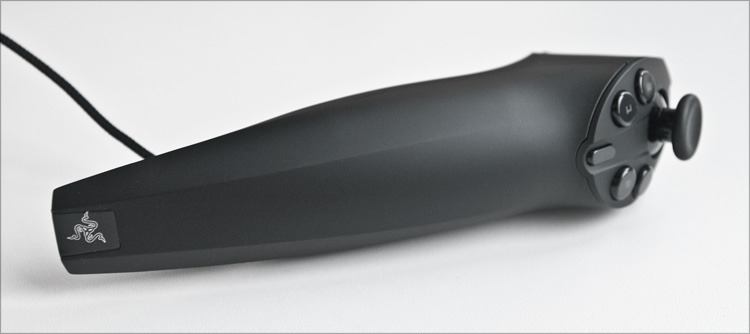
More recently, he went on sale on the Russian shelves and I had a chance to use it for a while - impressions under the cut.

')
I have not come across such devices yet, so I cannot say anything about the bundling. But everything you need is there: two manipulators, a “base”, a connecting USB wire and an instruction. All this is neatly packed in a trapezoidal box, which has the traditional black and green "battle" color.
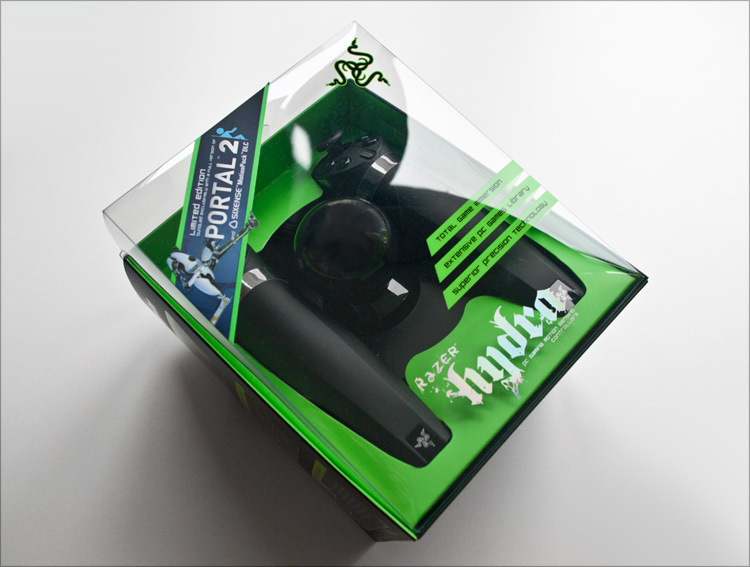
Included with the Razer Hydra is a game Portal2, which includes the addition of Sixense MotionPack DLC - six additional levels, specially designed for the Razer Hydra.
Razer has always been able to create an attractive design for devices — be it a keyboard, headphones, or a mouse pad. This time, in my opinion, everything is fine with the design too - at least there is definitely nothing awful.
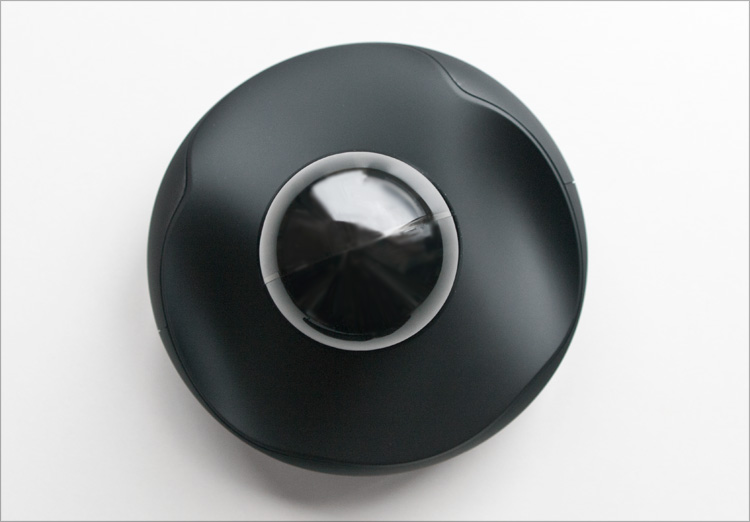
Let's start with the "base station" - a special device that coordinates the actions of the manipulators. It is a fairly massive "puck" of matte plastic, in the upper part of which there is a glossy ball. There are two indentations in the “puck” that are designed to install joysticks in them - in fact, they are not very securely held there, so everything was always on my desk separately.
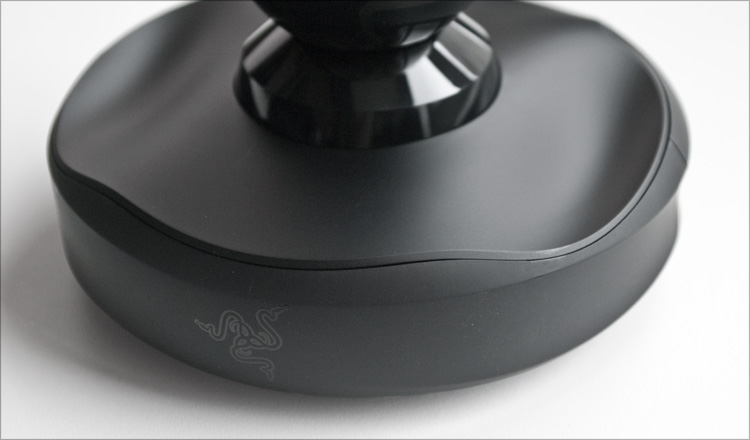
On the "base" there are two connectors (variations on the theme of USB), so it is the connecting link between the computer and the joysticks. All the wires from the kit have a protective sheath - they will not fray and will not get tangled once again.
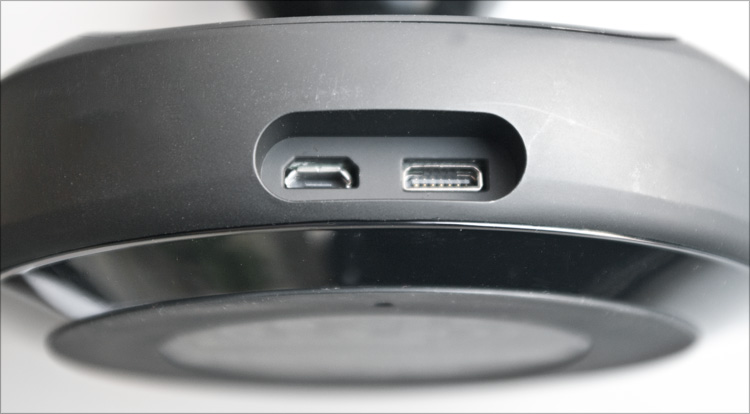
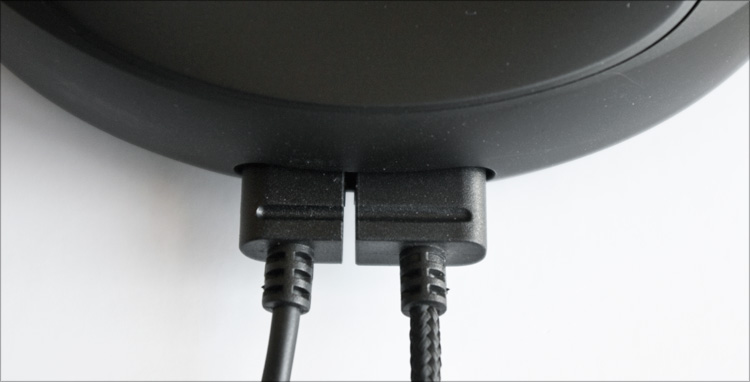
Externally, the ball is remarkable in that it pulsates with green light, but in fact it plays a key role - it generates a weak magnetic field around itself.
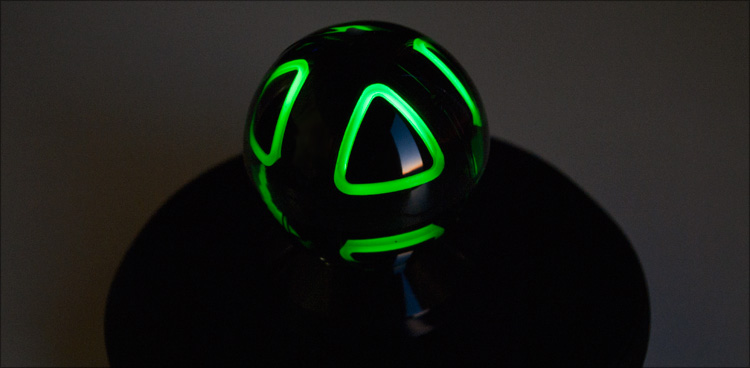
In this magnetic field, all activity is implied - it traces the slightest change in the position of the joysticks. To be more precise, not a single movement with an offset of more than 1 mm or 1 degree will be ignored - none of the competitors have such a positioning accuracy. The direct visibility of the controllers and the base is not required, but at a distance of 40 centimeters positioning errors become noticeable - you cannot move away.
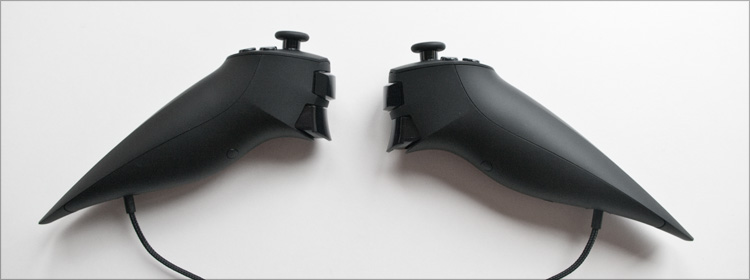
The manipulators themselves have an oblong conical shape, resembling a horn - on the one hand, sharp, on the other - stupid. They are entirely made of soft-touch plastic - something like a soft-touch; during active games, if hands sweat, there are almost no marks on the consoles. In the hands of the joysticks hold like a glove - ergonomics at a height.
Manipulators are absolutely symmetrical - both in terms of shape, and in terms of the location of the buttons. Each joystick has an analog stick, 5 action buttons and two triggers for shooting or quick response to the game situation.
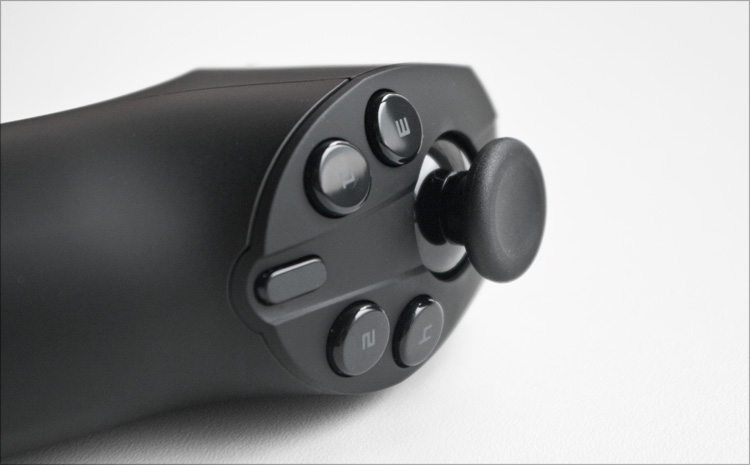
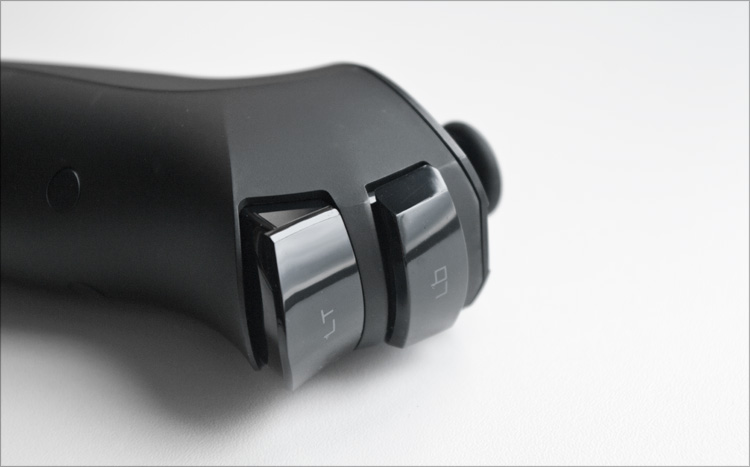
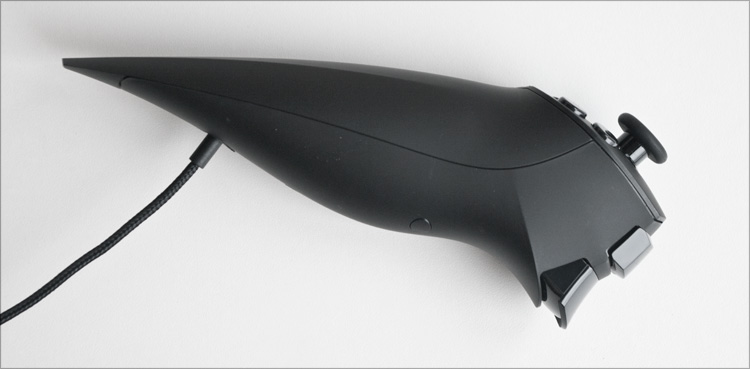
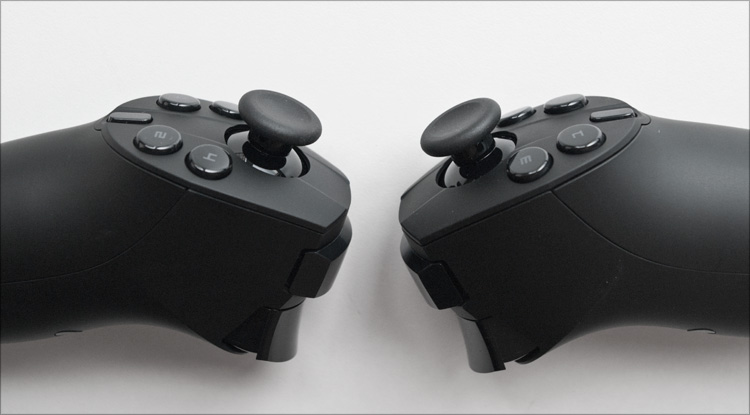
From each manipulator comes one wire - in practice, they only interfere, but it seems like the plans of companies include the release of a wireless version of the kit.
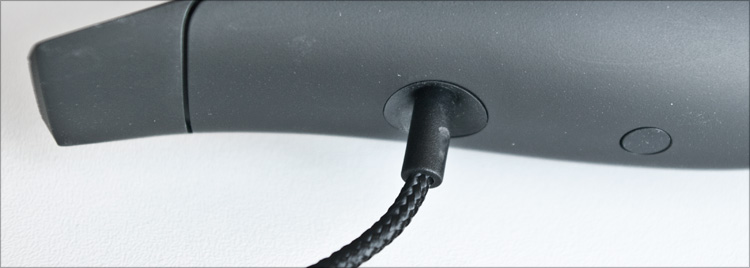
The Wii Mote and PS Move manipulators are involuntarily remembered, but on the other hand, there is not much in common between them - different appearance, platforms and principles of action. And in this case, we can assume that the PC has finally got its own "air" manipulator.
 For the full operation of the device, drivers are required, although no disks were included — it is better to simply download the latest version of the desired file from the network. After a moment, an icon appeared on the desktop - the Razer Hydra Configurator .
For the full operation of the device, drivers are required, although no disks were included — it is better to simply download the latest version of the desired file from the network. After a moment, an icon appeared on the desktop - the Razer Hydra Configurator .
After launch, the configurator offers to “identify” the right and left hand controls - due to their complete identity, successively press the button first on one, then on the second device.

And then everything is simple - choose the desired game in the configurator, memorize the buttons for the necessary actions (they are clearly and beautifully decorated), start the game and start chopping.
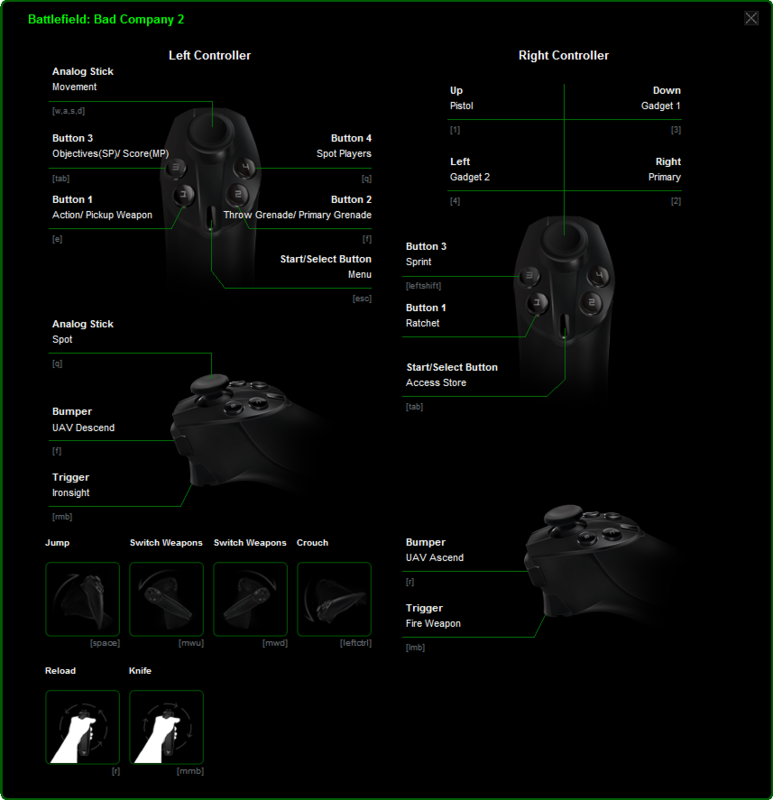
There are not many additional settings in the configurator - the backlight intensity, sensitivity and, in principle, everything.
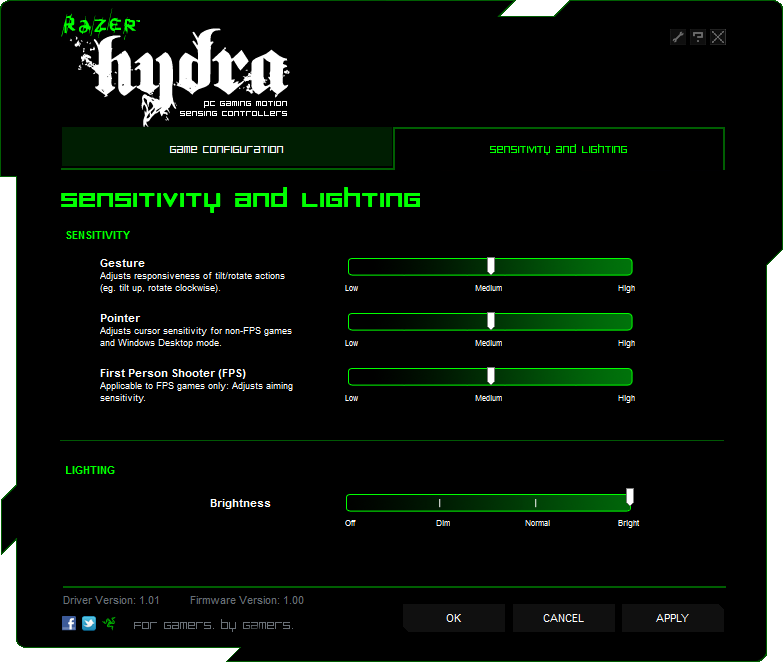
Regarding the number of compatible games on the Internet, there are deceptive misconceptions - they say, Hydra works ONLY in Portal 2 . No no no and no again! Firstly, the number of supported games is quite large and, apparently, it is constantly growing - at the moment there are profiles for approximately 150 games in the configurator (version 1.01). But secondly ... nothing prevents to create it yourself for any other game. All profiles (in the form of XML files) are located in the folder where the configurator is installed - we copy any profile, open it in a text editor and, by analogy, change a couple of lines depending on the needs.
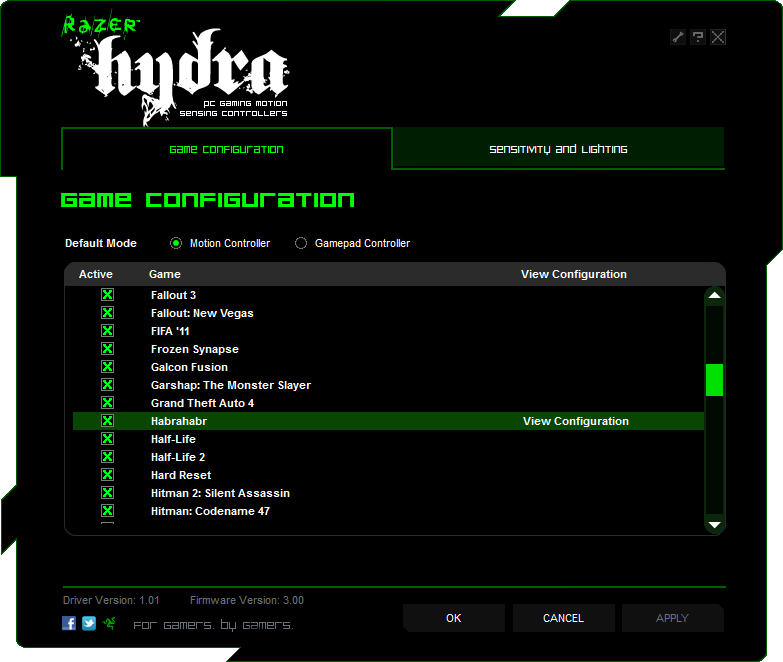
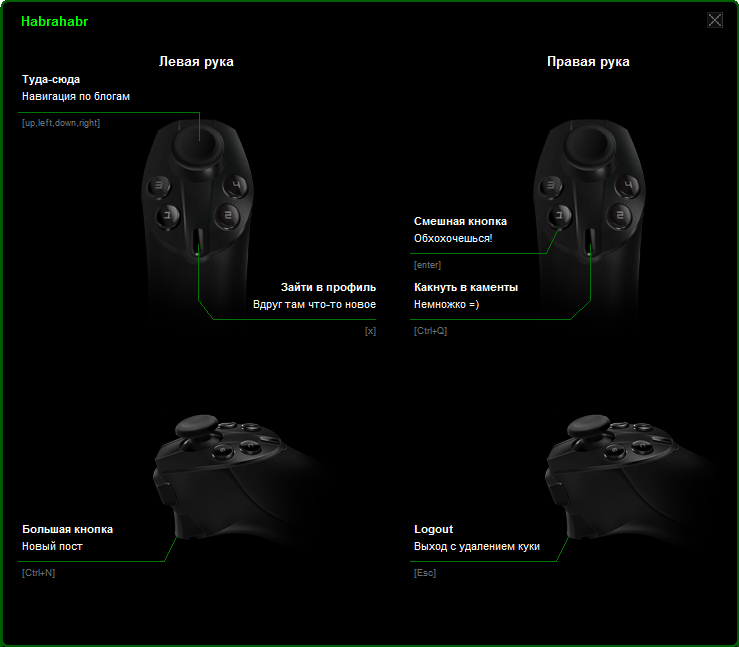
Yes, maybe this is not as convenient as we would like, but it gives certain freedoms - if there is at least an embryo of enthusiasm, everything will definitely work out. On the thematic forums, by the way, there are already quite a few “self-made” profiles, so it’s somehow silly to complain about the number of supported games.
In the system itself (Windows, although MacOS is also supported), the manipulators have no effect - only in games; and it is a pity - it would not be more than practice to manage the cursor. I played the following: " Portal 2 ", " Red Faction: Armageddon ", " Battlefield: Bad Company 2 " and " Call of Duty: Modern Warfare 2 " - all games fall into the category of action games, so in many ways the impressions are similar.

The first impression is rather strange: you drive "horns" in all directions, trying to get the cursor to the point "New game". After a minute, you control your movements more thoughtfully - you understand how to cause the necessary action, but you still turn off the game to tray to adjust the sensitivity. In another minute, you are already in the game - you twist-turn, press all the buttons, finally memorizing their actions - walking, jumping, changing weapons, reloading, shooting ...
Actually, the first ten minutes are still uncomfortable - all the time I want to take on the more familiar mouse and keyboard. But ... having come out in an hour of “torture” back to the Windows, having picked up the mouse, I realized that I had lost the habit of it - I wanted to continue waving my arms, to be free. I can only compare the effect with an hour of walking on a treadmill - when you get off of it, about 10 minutes then you learn to walk as before.
I really enjoyed moving with Razer Hydra - there are no crazy strafe, but otherwise the movements are very easy, easy and fun. For example, a jump is just a slight wave of one of the manipulators up, and squatting is a nod down. You experience some discomfort, trying to turn around 180 degrees - you need to be sensitive or “manual dexterity and no fraud”. But it will be most difficult to get used to shooting - to move the cursor into a moving target during the movement from the first time will not work exactly. And it is unlikely to work with the second. I only got my hand after a couple of episodes in RedFaction, but in the end, I still managed to do it better (and faster). But you have no idea how exciting the process of shooting has become - there is something pistol-shaped in the hand, and the index fingers lie directly on the "hooks". So playing shooters is much more interesting than stupidly drumming on the buttons of a mouse.
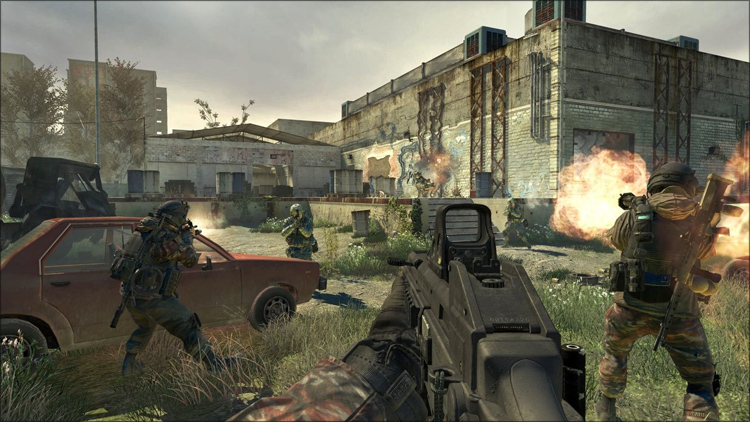
During the game, nothing gets tired, even, perhaps, on the contrary: the wrists move actively, the hands are always warm - hardly in this situation the “tunnel syndrome” has even the slightest chance. On the other hand, I know people who play 12-15 hours a day (if not more) - so much with these bagels, I probably would not have survived. But after all, you need to know the measure.
It’s impossible to say that it’s inconvenient to play - it’s just unusual, you need to train. Here, take a look at how it looks in practice:
Portal 2 :
Left 4 Dead 2 :
StarCraft 2 :
Motion controller (2 in each set)
- Ergonomic analog stick for smooth control
- 4 action buttons based on Hyperesponse technology
- Rapid fire trigger and bumper for quick response to the game situation
- Magnetic motion detection technology providing full six degrees of freedom
- Lightweight cable with protective sheath that prevents the formation of loops
- Non-slip matte grip surface
Base station
- Low power magnetic field, low power consumption
- Ultra-precise sensor (accuracy up to 1 mm and 1 degree)
- No direct visibility of controllers required
- Low latency
- Dimensions: 120 x 120 x 100 mm
- Weight: 800 g
Price: 4500 rubles
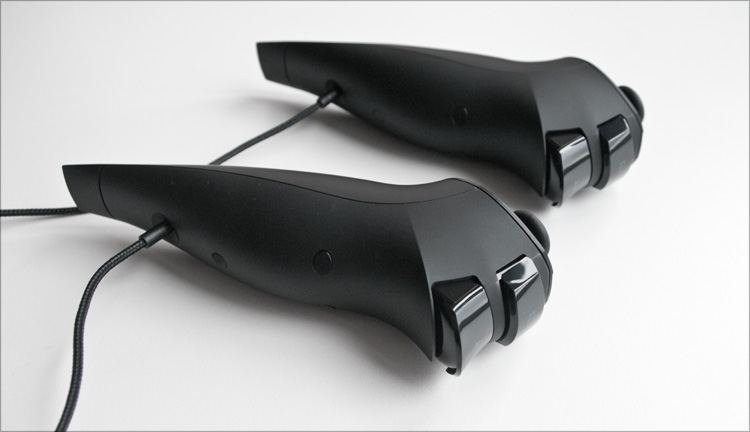
It's great that Razer is not afraid to experiment - not only in the design solutions of its products, but also in the search for new ways to interact with the virtual world. Only this approach allows you to constantly go forward, and not stagnate. As for the Hydra manipulator, it made a double impression on me - on the one hand, it’s great to wave and “shoot a finger”, on the other hand - you have to get used to it and the first impressions may not meet the expectations. But in any case, this is something new, unusual, and therefore interesting - agree that Razer would bite its elbows if someone released something similar to it and the product was successful.

More recently, he went on sale on the Russian shelves and I had a chance to use it for a while - impressions under the cut.

')
I have not come across such devices yet, so I cannot say anything about the bundling. But everything you need is there: two manipulators, a “base”, a connecting USB wire and an instruction. All this is neatly packed in a trapezoidal box, which has the traditional black and green "battle" color.

Included with the Razer Hydra is a game Portal2, which includes the addition of Sixense MotionPack DLC - six additional levels, specially designed for the Razer Hydra.
▌ Appearance.
Razer has always been able to create an attractive design for devices — be it a keyboard, headphones, or a mouse pad. This time, in my opinion, everything is fine with the design too - at least there is definitely nothing awful.

Let's start with the "base station" - a special device that coordinates the actions of the manipulators. It is a fairly massive "puck" of matte plastic, in the upper part of which there is a glossy ball. There are two indentations in the “puck” that are designed to install joysticks in them - in fact, they are not very securely held there, so everything was always on my desk separately.

On the "base" there are two connectors (variations on the theme of USB), so it is the connecting link between the computer and the joysticks. All the wires from the kit have a protective sheath - they will not fray and will not get tangled once again.


Externally, the ball is remarkable in that it pulsates with green light, but in fact it plays a key role - it generates a weak magnetic field around itself.

In this magnetic field, all activity is implied - it traces the slightest change in the position of the joysticks. To be more precise, not a single movement with an offset of more than 1 mm or 1 degree will be ignored - none of the competitors have such a positioning accuracy. The direct visibility of the controllers and the base is not required, but at a distance of 40 centimeters positioning errors become noticeable - you cannot move away.

The manipulators themselves have an oblong conical shape, resembling a horn - on the one hand, sharp, on the other - stupid. They are entirely made of soft-touch plastic - something like a soft-touch; during active games, if hands sweat, there are almost no marks on the consoles. In the hands of the joysticks hold like a glove - ergonomics at a height.
Manipulators are absolutely symmetrical - both in terms of shape, and in terms of the location of the buttons. Each joystick has an analog stick, 5 action buttons and two triggers for shooting or quick response to the game situation.




From each manipulator comes one wire - in practice, they only interfere, but it seems like the plans of companies include the release of a wireless version of the kit.

The Wii Mote and PS Move manipulators are involuntarily remembered, but on the other hand, there is not much in common between them - different appearance, platforms and principles of action. And in this case, we can assume that the PC has finally got its own "air" manipulator.
▌ Software.
 For the full operation of the device, drivers are required, although no disks were included — it is better to simply download the latest version of the desired file from the network. After a moment, an icon appeared on the desktop - the Razer Hydra Configurator .
For the full operation of the device, drivers are required, although no disks were included — it is better to simply download the latest version of the desired file from the network. After a moment, an icon appeared on the desktop - the Razer Hydra Configurator .After launch, the configurator offers to “identify” the right and left hand controls - due to their complete identity, successively press the button first on one, then on the second device.

And then everything is simple - choose the desired game in the configurator, memorize the buttons for the necessary actions (they are clearly and beautifully decorated), start the game and start chopping.

There are not many additional settings in the configurator - the backlight intensity, sensitivity and, in principle, everything.

Regarding the number of compatible games on the Internet, there are deceptive misconceptions - they say, Hydra works ONLY in Portal 2 . No no no and no again! Firstly, the number of supported games is quite large and, apparently, it is constantly growing - at the moment there are profiles for approximately 150 games in the configurator (version 1.01). But secondly ... nothing prevents to create it yourself for any other game. All profiles (in the form of XML files) are located in the folder where the configurator is installed - we copy any profile, open it in a text editor and, by analogy, change a couple of lines depending on the needs.


Yes, maybe this is not as convenient as we would like, but it gives certain freedoms - if there is at least an embryo of enthusiasm, everything will definitely work out. On the thematic forums, by the way, there are already quite a few “self-made” profiles, so it’s somehow silly to complain about the number of supported games.
▌ Gameplay. GL
In the system itself (Windows, although MacOS is also supported), the manipulators have no effect - only in games; and it is a pity - it would not be more than practice to manage the cursor. I played the following: " Portal 2 ", " Red Faction: Armageddon ", " Battlefield: Bad Company 2 " and " Call of Duty: Modern Warfare 2 " - all games fall into the category of action games, so in many ways the impressions are similar.

The first impression is rather strange: you drive "horns" in all directions, trying to get the cursor to the point "New game". After a minute, you control your movements more thoughtfully - you understand how to cause the necessary action, but you still turn off the game to tray to adjust the sensitivity. In another minute, you are already in the game - you twist-turn, press all the buttons, finally memorizing their actions - walking, jumping, changing weapons, reloading, shooting ...
Actually, the first ten minutes are still uncomfortable - all the time I want to take on the more familiar mouse and keyboard. But ... having come out in an hour of “torture” back to the Windows, having picked up the mouse, I realized that I had lost the habit of it - I wanted to continue waving my arms, to be free. I can only compare the effect with an hour of walking on a treadmill - when you get off of it, about 10 minutes then you learn to walk as before.
I really enjoyed moving with Razer Hydra - there are no crazy strafe, but otherwise the movements are very easy, easy and fun. For example, a jump is just a slight wave of one of the manipulators up, and squatting is a nod down. You experience some discomfort, trying to turn around 180 degrees - you need to be sensitive or “manual dexterity and no fraud”. But it will be most difficult to get used to shooting - to move the cursor into a moving target during the movement from the first time will not work exactly. And it is unlikely to work with the second. I only got my hand after a couple of episodes in RedFaction, but in the end, I still managed to do it better (and faster). But you have no idea how exciting the process of shooting has become - there is something pistol-shaped in the hand, and the index fingers lie directly on the "hooks". So playing shooters is much more interesting than stupidly drumming on the buttons of a mouse.

During the game, nothing gets tired, even, perhaps, on the contrary: the wrists move actively, the hands are always warm - hardly in this situation the “tunnel syndrome” has even the slightest chance. On the other hand, I know people who play 12-15 hours a day (if not more) - so much with these bagels, I probably would not have survived. But after all, you need to know the measure.
It’s impossible to say that it’s inconvenient to play - it’s just unusual, you need to train. Here, take a look at how it looks in practice:
Portal 2 :
Left 4 Dead 2 :
StarCraft 2 :
▌ Specifications. TTX
Motion controller (2 in each set)
- Ergonomic analog stick for smooth control
- 4 action buttons based on Hyperesponse technology
- Rapid fire trigger and bumper for quick response to the game situation
- Magnetic motion detection technology providing full six degrees of freedom
- Lightweight cable with protective sheath that prevents the formation of loops
- Non-slip matte grip surface
Base station
- Low power magnetic field, low power consumption
- Ultra-precise sensor (accuracy up to 1 mm and 1 degree)
- No direct visibility of controllers required
- Low latency
- Dimensions: 120 x 120 x 100 mm
- Weight: 800 g
Price: 4500 rubles

▌ Conclusion. Gg
It's great that Razer is not afraid to experiment - not only in the design solutions of its products, but also in the search for new ways to interact with the virtual world. Only this approach allows you to constantly go forward, and not stagnate. As for the Hydra manipulator, it made a double impression on me - on the one hand, it’s great to wave and “shoot a finger”, on the other hand - you have to get used to it and the first impressions may not meet the expectations. But in any case, this is something new, unusual, and therefore interesting - agree that Razer would bite its elbows if someone released something similar to it and the product was successful.
Source: https://habr.com/ru/post/133487/
All Articles